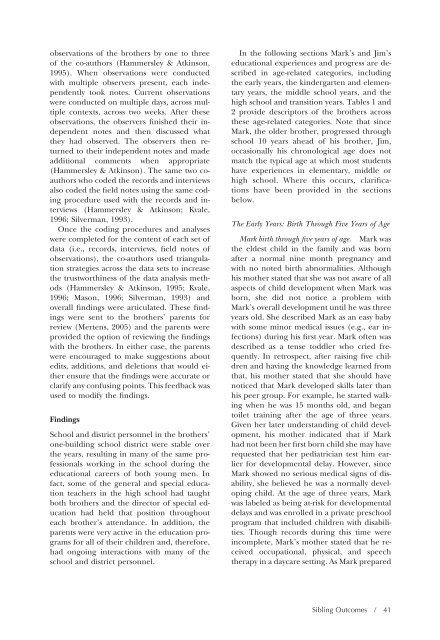Download The Journal (PDF) - Division on Autism and ...
Download The Journal (PDF) - Division on Autism and ...
Download The Journal (PDF) - Division on Autism and ...
You also want an ePaper? Increase the reach of your titles
YUMPU automatically turns print PDFs into web optimized ePapers that Google loves.
observati<strong>on</strong>s of the brothers by <strong>on</strong>e to three<br />
of the co-authors (Hammersley & Atkins<strong>on</strong>,<br />
1995). When observati<strong>on</strong>s were c<strong>on</strong>ducted<br />
with multiple observers present, each independently<br />
took notes. Current observati<strong>on</strong>s<br />
were c<strong>on</strong>ducted <strong>on</strong> multiple days, across multiple<br />
c<strong>on</strong>texts, across two weeks. After these<br />
observati<strong>on</strong>s, the observers finished their independent<br />
notes <strong>and</strong> then discussed what<br />
they had observed. <str<strong>on</strong>g>The</str<strong>on</strong>g> observers then returned<br />
to their independent notes <strong>and</strong> made<br />
additi<strong>on</strong>al comments when appropriate<br />
(Hammersley & Atkins<strong>on</strong>). <str<strong>on</strong>g>The</str<strong>on</strong>g> same two coauthors<br />
who coded the records <strong>and</strong> interviews<br />
also coded the field notes using the same coding<br />
procedure used with the records <strong>and</strong> interviews<br />
(Hammersley & Atkins<strong>on</strong>; Kvale,<br />
1996; Silverman, 1993).<br />
Once the coding procedures <strong>and</strong> analyses<br />
were completed for the c<strong>on</strong>tent of each set of<br />
data (i.e., records, interviews, field notes of<br />
observati<strong>on</strong>s), the co-authors used triangulati<strong>on</strong><br />
strategies across the data sets to increase<br />
the trustworthiness of the data analysis methods<br />
(Hammersley & Atkins<strong>on</strong>, 1995; Kvale,<br />
1996; Mas<strong>on</strong>, 1996; Silverman, 1993) <strong>and</strong><br />
overall findings were articulated. <str<strong>on</strong>g>The</str<strong>on</strong>g>se findings<br />
were sent to the brothers’ parents for<br />
review (Mertens, 2005) <strong>and</strong> the parents were<br />
provided the opti<strong>on</strong> of reviewing the findings<br />
with the brothers. In either case, the parents<br />
were encouraged to make suggesti<strong>on</strong>s about<br />
edits, additi<strong>on</strong>s, <strong>and</strong> deleti<strong>on</strong>s that would either<br />
ensure that the findings were accurate or<br />
clarify any c<strong>on</strong>fusing points. This feedback was<br />
used to modify the findings.<br />
Findings<br />
School <strong>and</strong> district pers<strong>on</strong>nel in the brothers’<br />
<strong>on</strong>e-building school district were stable over<br />
the years, resulting in many of the same professi<strong>on</strong>als<br />
working in the school during the<br />
educati<strong>on</strong>al careers of both young men. In<br />
fact, some of the general <strong>and</strong> special educati<strong>on</strong><br />
teachers in the high school had taught<br />
both brothers <strong>and</strong> the director of special educati<strong>on</strong><br />
had held that positi<strong>on</strong> throughout<br />
each brother’s attendance. In additi<strong>on</strong>, the<br />
parents were very active in the educati<strong>on</strong> programs<br />
for all of their children <strong>and</strong>, therefore,<br />
had <strong>on</strong>going interacti<strong>on</strong>s with many of the<br />
school <strong>and</strong> district pers<strong>on</strong>nel.<br />
In the following secti<strong>on</strong>s Mark’s <strong>and</strong> Jim’s<br />
educati<strong>on</strong>al experiences <strong>and</strong> progress are described<br />
in age-related categories, including<br />
the early years, the kindergarten <strong>and</strong> elementary<br />
years, the middle school years, <strong>and</strong> the<br />
high school <strong>and</strong> transiti<strong>on</strong> years. Tables 1 <strong>and</strong><br />
2 provide descriptors of the brothers across<br />
these age-related categories. Note that since<br />
Mark, the older brother, progressed through<br />
school 10 years ahead of his brother, Jim,<br />
occasi<strong>on</strong>ally his chr<strong>on</strong>ological age does not<br />
match the typical age at which most students<br />
have experiences in elementary, middle or<br />
high school. Where this occurs, clarificati<strong>on</strong>s<br />
have been provided in the secti<strong>on</strong>s<br />
below.<br />
<str<strong>on</strong>g>The</str<strong>on</strong>g> Early Years: Birth Through Five Years of Age<br />
Mark birth through five years of age. Mark was<br />
the eldest child in the family <strong>and</strong> was born<br />
after a normal nine m<strong>on</strong>th pregnancy <strong>and</strong><br />
with no noted birth abnormalities. Although<br />
his mother stated that she was not aware of all<br />
aspects of child development when Mark was<br />
born, she did not notice a problem with<br />
Mark’s overall development until he was three<br />
years old. She described Mark as an easy baby<br />
with some minor medical issues (e.g., ear infecti<strong>on</strong>s)<br />
during his first year. Mark often was<br />
described as a tense toddler who cried frequently.<br />
In retrospect, after raising five children<br />
<strong>and</strong> having the knowledge learned from<br />
that, his mother stated that she should have<br />
noticed that Mark developed skills later than<br />
his peer group. For example, he started walking<br />
when he was 15 m<strong>on</strong>ths old, <strong>and</strong> began<br />
toilet training after the age of three years.<br />
Given her later underst<strong>and</strong>ing of child development,<br />
his mother indicated that if Mark<br />
had not been her first born child she may have<br />
requested that her pediatrician test him earlier<br />
for developmental delay. However, since<br />
Mark showed no serious medical signs of disability,<br />
she believed he was a normally developing<br />
child. At the age of three years, Mark<br />
was labeled as being at-risk for developmental<br />
delays <strong>and</strong> was enrolled in a private preschool<br />
program that included children with disabilities.<br />
Though records during this time were<br />
incomplete, Mark’s mother stated that he received<br />
occupati<strong>on</strong>al, physical, <strong>and</strong> speech<br />
therapy in a daycare setting. As Mark prepared<br />
Sibling Outcomes / 41

















